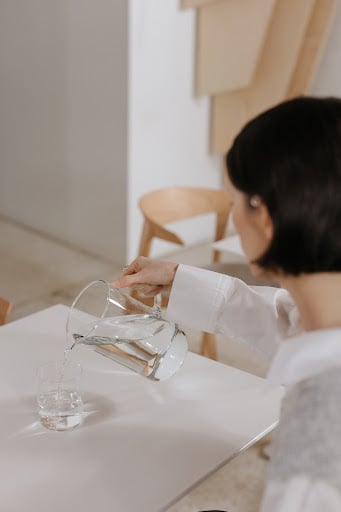Proper hydration is an important part of healthy living year round, but with soaring temperatures in the summer, it’s a good time to check in with your hydration needs and habits. The body is made up of about 60 percent water, making h2O truly an essential factor in optimal function.
You’ve likely heard the general recommendation to drink eight glasses of water per day. Well it turns out that might not be enough, depending on factors like age, weight, and level of physical activity. According to the U.S. National Academies of Sciences, Engineering, and Medicine, the average adult should get anywhere from 11.5 cups to 15.5 cups of water per day.1 Those fluids can come from drinking water or eating water-rich foods. Another quick way to calculate how much water you should drink per day is by taking your body weight and dividing it by two. That number is the minimum ounces of water you should drink per day, according to the University of Missouri System.2
To increase your daily water intake, try adding these hydration habits into your routine:
- Start the day with water: It’s tempting to start your morning with a cup of coffee or tea for a kick of caffeine. But before you reach for your beverage of choice, try drinking 8 to 12 ounces of plain water first to get a head start on your water consumption for the day.
- Eat water-rich foods: Staying hydrated doesn’t have to come solely from drinking water. Incorporating more water-rich foods into your diet can help increase your daily water intake. These include—cucumbers, tomatoes, watermelon, apples, lettuce, zucchini, peaches and celery.
- Pay attention to urine color: It sounds silly and gross, but the color of your pee can tell you a lot about your body’s hydration level. If your urine is a shade of dark yellow or brown, it’s a sign that you haven’t had enough fluids. The ideal urine color is clear or pale yellow in order to pass the hydration test.
- Drink before you’re thirsty: One major sign of dehydration is feeling thirsty or dry mouth. If you’re feeling parched, there’s a good chance your body is already dehydrated. Instead of making up for it when your body signals thirst, drink water before you’re even thirsty to keep hydration levels high.
- Try water flavorings: Water isn’t the most exciting drink out there, but it doesn’t have to be boring. There are plenty of water flavoring products that can give you variety and taste if drinking plain water is a challenge. Top brands include—Nuun, Cirkul and True Lemon.
Signs of Dehydration
Dehydration is a serious condition and symptoms should not be ignored. Signs of dehydration include:
- Thirst or dry mouth
- Dark-colored urine
- Peeing less frequently
- Dry skin
- Fatigue
- Confusion
- Dizziness
According to the Mayo Clinic, drinking fluids can usually treat mild to moderate dehydration symptoms, but severe dehydration requires immediate medical attention.3 Consider drinking more water than usual if you plan to be more physically active, spend a lot of time outdoors in warm temperatures or if you are pregnant.
About the Author:
Ciara Lucas is a journalist, on-air talent, media professional, and fitness/wellness coach. Her multifaceted career brings a unique perspective and expertise to the Vionic Innovation Lab team.
Ciara’s professional career has encompassed contributing to local and national newsrooms including NBC Nightly News with Lester Holt, NBC Sports for the 2016 Summer Olympics in Rio de Janerio, Brazil, and NBC News coverage of the 50th anniversary of the Selma to Montgomery march. When she’s not on screen, she’s building connections strengthened through sweat as a certified personal trainer and nutrition coach, helping clients find their meaning of sustainable health and happiness.
Ciara has created a personal brand and platform titled “Fit For A Queen” where she aims to empower, motivate, and inspire women from all walks of life to nurture their health and live their best lives by treating their bodies well. She is also an active member of the nonprofit Girls on the Run where she serves as a run coach for elementary school girls.
References:
- “Report Sets Dietary Intake Levels for Water, Salt, and Potassium to Maintain Health and Reduce Chronic Disease Risk”. National Academies, The National Academies Press, February 2004, https://www.nationalacademies.org/news/2004/02/report-sets-dietary-intake-levels-for-water-salt-and-potassium-to-maintain-health-and-reduce-chronic-disease-risk
- “How to Calculate How Much Water You Should Drink”. University of Missouri System Total Rewards – Wellness Program, University of Missouri System, https://www.umsystem.edu/totalrewards/wellness/how-to-calculate-how-much-water-you-should-drink
- “Dehydration – Symptoms and Causes.” Mayo Foundation for Medical Education and Research, https://www.mayoclinic.org/diseases-conditions/dehydration/symptoms-causes/syc-20354086


Leave a Reply